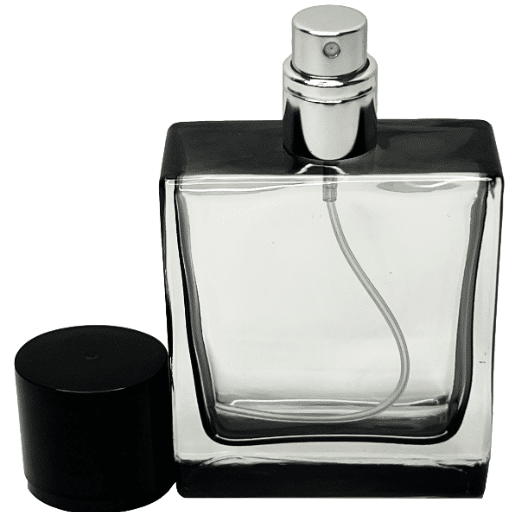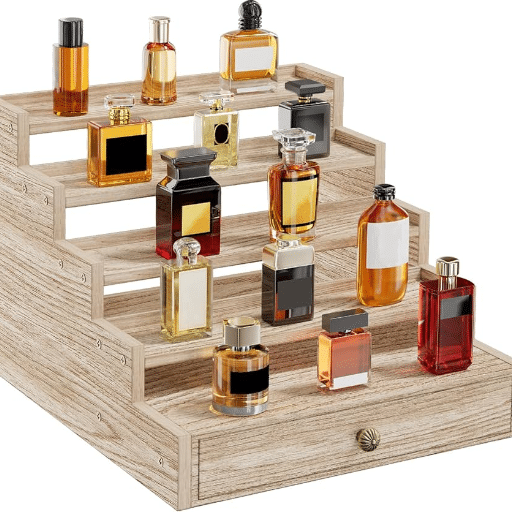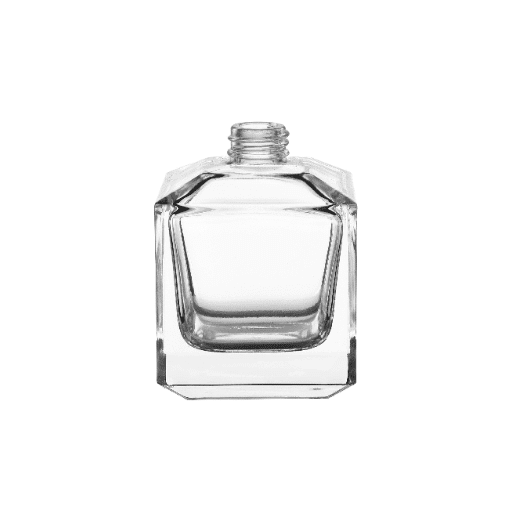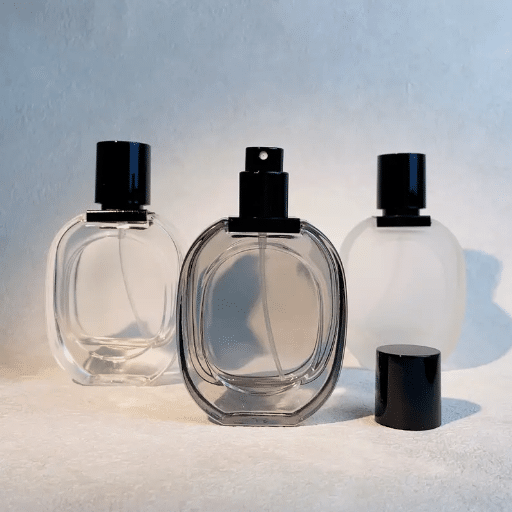Whether you need a travel-sized bottle or want to share your favorite fragrance, transferring perfume requires the right technique and tools. This comprehensive guide will walk you through the entire process while preserving your precious fragrance’s integrity and quality.
Why Transfer Perfume?
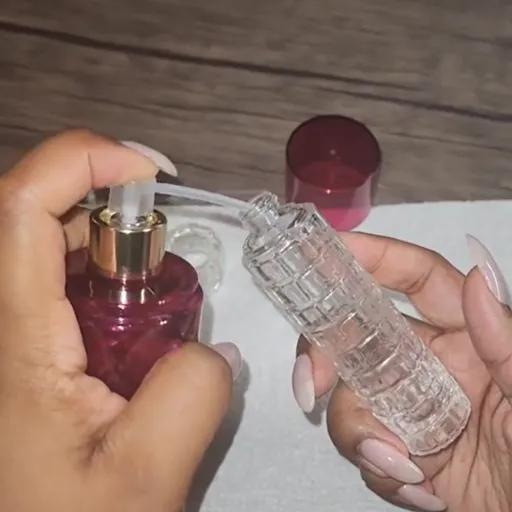
Transferring perfume has become increasingly popular for practical and convenience reasons. From airline liquid restrictions to the desire for portable luxury, there are numerous compelling reasons to master this skill.
Travel Convenience
Airline liquid restrictions and bulky bottles make travel difficult. Small, portable containers let you carry your favorite scent anywhere without compromise.
Preservation
Minimize exposure to air and light that can degrade fragrance over time. Smaller bottles reduce oxidation and extend your perfume’s lifespan.
Sharing & Gifting
Share beloved fragrances with friends or create personalized gifts. Transfer small amounts to introduce others to your favorite scents.
Environmental Responsibility
Reuse containers and reduce waste. Transferring perfume supports eco-friendly practices by extending the life of existing bottles.
Choosing the Right Container
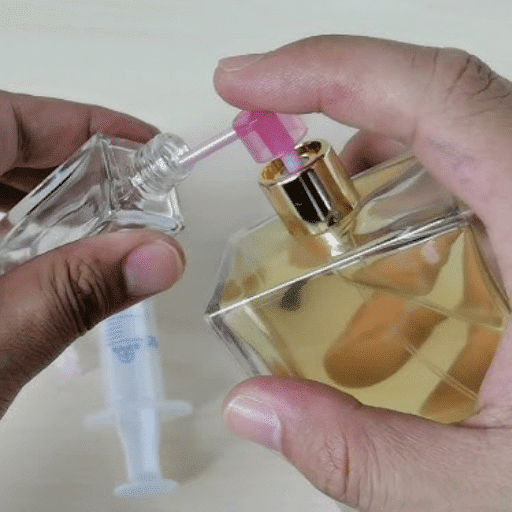
The container you select plays a crucial role in maintaining your perfume’s quality and ensuring successful transfer. Different materials and designs offer unique advantages for various applications.
Glass Bottles
Best for: Long-term storage and premium presentation
Non-reactive material that preserves fragrance integrity. Available in clear, frosted, or colored varieties for light protection and aesthetic appeal.
Roller Bottles
Best for: Precise application and travel
Highly portable with controlled dispensing. Perfect for pulse point application and preventing over-use of precious fragrances.
Atomizers
Best for: Even distribution and professional application
Create fine mist for optimal coverage while minimizing waste and air exposure during application.
Travel Bottles
Best for: Portability and security
Leak-proof design specifically engineered for transport. Usually refillable with secure caps to prevent accidents.
High-Grade Plastic
Best for: Budget-conscious and lightweight needs
Choose BPA-free, high-quality plastic to avoid chemical reactions that could alter your fragrance composition.
Ceramic Bottles
Best for: Luxury presentation and protection
Artisanal appeal with excellent fragrance protection. Ideal for special occasions and collector presentations.
Material Selection Guide
Glass is the gold standard for fragrance storage due to its non-reactive properties. If you must use plastic, ensure it’s high-grade and BPA-free to prevent chemical interactions that could alter your perfume’s scent profile.
Transfer Methods
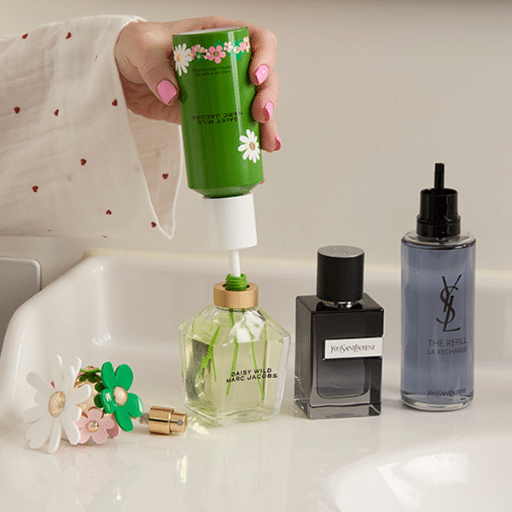
Different transfer methods suit various bottle types and situations. Understanding when and how to use each technique ensures successful results with minimal waste.
Spray Atomizer Method
Perfect for refillable travel atomizers with bottom-fill valves. Simply connect the valve to your main perfume bottle’s nozzle and pump until filled. This method maintains cleanliness and prevents contamination.
- Clean and efficient process
- Minimal air exposure
- No additional tools required
- Works with most spray bottles
Pipette Method
Ideal for precise control and small quantities. Use a clean glass pipette to extract exact amounts and apply drop by drop. This method offers maximum precision and minimal waste.
- Excellent precision control
- Perfect for small quantities
- Minimal product waste
- Easy to clean and sanitize
Funnel Technique
Best for larger transfers from splash bottles. Remove the spray nozzle, use a clean small funnel, and pour steadily. This traditional method works well for substantial quantity transfers.
- Handles larger volumes efficiently
- Works with splash bottles
- Reduces spill risk significantly
- Simple and straightforward process
Syringe Method
Provides maximum control for delicate operations. Remove spray nozzle, extract liquid with syringe, and transfer carefully. Excellent for valuable or concentrated fragrances.
- Ultimate precision and control
- Works with any bottle type
- Minimal air exposure during transfer
- Easy measurement of exact quantities
Essential Tools and Equipment
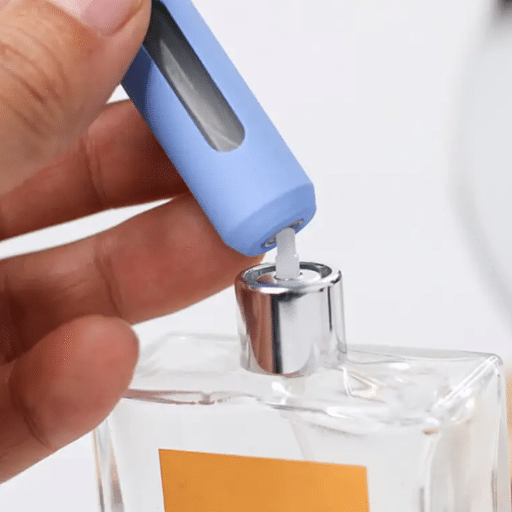
Clean Glass Funnel
Essential for spill-free pouring. Choose size appropriate for your bottle opening. Stainless steel or glass options provide best chemical compatibility.
Glass Pipettes
Perfect for precise measurements and delicate transfers. Disposable options ensure contamination-free operation for each fragrance.
Small Syringes
Provide maximum control for valuable fragrances. Choose plastic-free options when possible to avoid chemical interactions.
Cleaning Supplies
Isopropyl alcohol, lint-free cloths, and cotton swabs for sterilizing equipment and cleaning spills.
Work Surface Protection
Absorbent mats or towels to protect surfaces and catch accidental spills during the transfer process.
Labels
Waterproof labels to identify transferred fragrances and track transfer dates for quality monitoring.
Recommended Travel Bottles and Atomizers
| Product Type | Best Features | Ideal Use Case | Size Range |
|---|---|---|---|
| Travalo Atomizers | Direct refill system, elegant design, leak-proof | Frequent travelers, luxury presentation | 5ml – 15ml |
| Sephora Refillable Sprays | Stylish design, easy refilling, compact size | Daily use, gift giving | 10ml – 30ml |
| Glass Roller Bottles | Precise application, durable, cost-effective | Personal use, essential oils | 5ml – 15ml |
| Nalgene Travel Bottles | Leak-proof, durable, multiple sizes | Extended travel, outdoor activities | 15ml – 100ml |
Step-by-Step Transfer Process
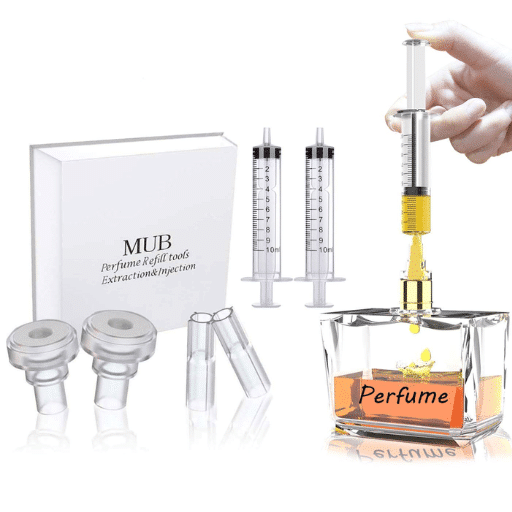
Prepare Your Workspace
Work in a clean, well-lit area away from direct sunlight and heat. Lay down protective covering and ensure good ventilation. Gather all tools and containers before beginning.
Sterilize Equipment
Clean all tools with isopropyl alcohol and allow to air dry completely. This prevents contamination and preserves fragrance quality.
Remove Original Cap/Nozzle
Carefully remove the spray nozzle or cap from your original perfume bottle. Some may require gentle twisting or pulling. Keep components clean and safe.
Select Transfer Method
Choose appropriate method based on bottle types: funnel for large transfers, pipette for precision, or direct pumping for compatible atomizers.
Execute Transfer Slowly
Work deliberately and steadily. Pour slowly to prevent splashing, maintain control, and minimize air exposure. Stop periodically to assess progress.
Seal Immediately
Cap both bottles immediately after transfer to prevent evaporation and oxidation. Ensure tight seals on all containers.
Clean Up and Label
Wipe down all surfaces, clean tools, and label your new container with fragrance name and transfer date for future reference.
Best Practices for Success
Professional Transfer Tips
- Temperature Control: Work at room temperature (68-72°F) to prevent expansion/contraction issues
- Lighting Awareness: Avoid direct sunlight and UV exposure during transfer process
- Small Batches: Work with 10-15ml quantities to minimize air exposure time
- Quality Containers: Invest in dark glass bottles with airtight seals for best preservation
- Documentation: Keep records of transfer dates and original fragrance details
Avoiding Contamination
Critical Safety Measures
- Sterile Environment: Use sterilized equipment and work in clean conditions
- Minimize Air Contact: Work quickly to reduce oxidation exposure
- Wear Protection: Use gloves to prevent skin oils from contaminating fragrance
- Avoid Cross-Contamination: Never reuse tools between different fragrances
- Immediate Sealing: Cap containers immediately after transfer completion
Preserving Fragrance Quality
Storage Optimization
Proper storage after transfer is crucial for maintaining fragrance integrity. Store in cool, dark environments at 60-70°F (15-21°C) with consistent temperature to prevent molecular breakdown.
Quality Preservation Guidelines
| Factor | Optimal Conditions | What to Avoid | Impact on Quality |
|---|---|---|---|
| Temperature | 60-70°F (15-21°C), consistent conditions | Heat sources, temperature fluctuations | Heat accelerates molecular breakdown |
| Light Exposure | Dark storage, opaque containers | Direct sunlight, UV exposure | UV rays cause chemical alterations |
| Air Contact | Airtight seals, minimal headspace | Loose caps, frequent opening | Oxidation changes scent profile |
| Humidity | Low humidity environments | Bathrooms, humid areas | Moisture affects chemical stability |
| Container Material | Dark glass, non-reactive materials | Clear plastic, reactive metals | Poor materials alter fragrance composition |
Shelf Life Considerations
Monitor Your Transfers: Most fragrances maintain quality for 3-5 years when properly stored. However, transferred perfumes may have shorter lifespans due to increased air exposure during the process. Check regularly for changes in color, scent, or consistency.
Troubleshooting Common Issues
Cloudy Appearance
Cause: Temperature shock or contamination
Solution: Allow to return to room temperature gradually. If cloudiness persists, the fragrance may be compromised.
Changed Scent
Cause: Oxidation or contamination
Solution: Check storage conditions and container cleanliness. Consider the age of the original fragrance.
Reduced Longevity
Cause: Alcohol evaporation or dilution
Solution: Ensure airtight sealing and proper storage temperature. Avoid frequent opening.
Separation Issues
Cause: Temperature changes or poor mixing
Solution: Gentle swirling may help, but separation often indicates degradation.
References
-
How to Fix a Broken Perfume Nozzle: Get Your Favorite Fragrance Flowing Again
University of San Diego
This guide explains how to decant perfume into a new bottle using tools like funnels or pipettes, ensuring cleanliness and safety. -
Exploring the World of Tiny Perfume Bottles: A Miniature Fragrance Revolution
Butler University
This article provides insights into handling and transferring perfume into smaller bottles, including tips for removing spray nozzles.
Frequently Asked Questions (FAQ)
What is the safest way of transferring perfume to a travel bottle?
Transfer perfume into a travel bottle with a small funnel. This allows a gentle pour of eco-friendly perfume into the travel bottle without spill. It’s essential to ensure the funnel fits snugly into the travel bottle opening to avoid it spilling over.
How to avoid spilling while transferring perfume?
Pouring perfume with a steady hand is important. Always keep the bottle aligned into the funnel perfectly. Moving slowly also assists in ensuring the travel bottle fills correctly without overflowing.
Does one remove the sprayer before transferring perfume?
Yes, it is helpful to remove the sprayer from the original bottle, easy filling of the perfume bottle to occur. Then, simply pour or fill the new container with the use of a small funnel with whatever portion of perfume you want.
Is it good to use soap and water to clean my travel bottle?
Yes. It is recommended to clean your travel bottle with soap and water. Once the cleaning is done, ensure it is totally dried before filling in perfume, as it could lead to the contamination of the perfume. You might as well use parafilm to seal the bottle tightly once it’s filled.
How much perfume should be transferred into a travel bottle?
A travel bottle is usually designed to accommodate about 15 ml-100 ml of perfume. So, check your travel bottle specifications to ensure proper filling and avoid overfilling it.
Is it safe to transfer perfume from a full bottle?
It is safe to divide perfume from a full bottle as long as certain precautions are taken. Use a funnel and a steady hand to slowly pour the perfume into the travel bottle to avoid spills and evaporation.
What options do I have whenever I want to carry my most beloved fragrance on a trip?
You can transfer a bit of perfume into a travel perfume bottle if you want to bring your favourite perfume on a trip. This allows you to carry your scent without lugging the bulkier mother bottle along.
Can splash bottles be employed to transfer perfume?
Splash bottles may be used to transfer perfume, but extra care is required. Pouring slowly into the splash bottle helps prevent spills and ensures the bottle will be evenly filled.

